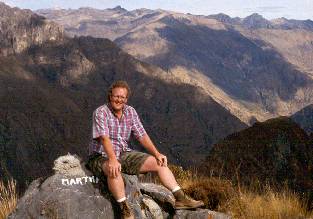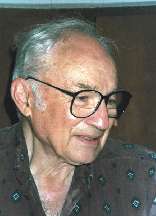







 |
 |
 |
 |
|||||
 |
 |
 |
||||||
 |
||||||||
| News
about people and
announcements from AGI's 37 member societies ______________________ |
To post news in Society Page, send e-mail to geotimes@agiweb.org with the subject: Society Page. |
The American Geological Institute welcomed two new member societies at the end of 2000. In February Geotimes interviewed Philippe Theys, president of the Society of Professional Well Log Analysts. This month we talk with John Nicholl, president of the Environmental and Engineering Geophysical Society.
[Photo: John Nicholl takes a break from working in the Peruvian Andes. Courtesy of J. Nicholl]
 What
developments do you see in the field of environmental and engineering geophysics
in today’s society?
What
developments do you see in the field of environmental and engineering geophysics
in today’s society?
New technologies applied to both geophysical instrumentation and computers
are helping us get more out of collected geophysical data than ever before.
We are thus able to collect more high-quality geophysical data while eliminating
geophysical noise, and we are able to process and interpret large volumes
of geophysical data very rapidly. It is exciting being able to address
potential problems of subsurface characterization requirements that were
extremely difficult or impossible only a few short years ago.
How did EEGS get started?
EEGS is a young society founded in 1992. It was formed initially as
an outgrowth in support of SAGEEP, the Symposium on the Application of
Geophysics to Engineering and Environmental Problems. EEGS publishes a
quarterly newsletter called FastTimes, and a scientific publication entitled
the Journal of Environmental and Engineering Geophysics, also a quarterly.
EEGS has also developed several tools, such as a geophysical tutorial on
CD-ROM, designed to educate on the appropriate use of geophysical techniques
and the value of implementing them.
How will a Bush administration affect your field?
Although we have not discussed the election among our Board members,
my personal belief is that a Bush administration will have a positive impact
on our field. I believe that the new administration will have greater balance
between environmental concerns and resource development. This should translate
into a more cooperative regulatory environment and thus greater trust between
business concerns and the federal regulatory agencies. This more positive
tone should also facilitate greater redevelopment of commercial urban properties
and other brownfield sites requiring geophysical characterization.
In what ways can you encourage students to pursue careers in geophysics,
specifically looking at environmental and engineering problems?
Using shallow geophysics for environmental and engineering issues will
continue to be a rewarding and challenging career path. Geophysics will
continue to be used to characterize sites containing hazardous waste and
other environmentally damaging materials. It will also continue to help
identify subsurface features for regulatory compliance at hazardous waste
or contaminated sites.
Geophysical methods help illustrate the design needs of engineered structures such as dams and other water projects, highways, tunnels, bridges and large buildings. A growing area for geophysics implementation, which overlaps both environmental and engineering applications, is in site closure for mines or petroleum production sites.
How might EEGS help those outside its membership?
We believe the major reason that geophysics is underutilized is a lack
of understanding of its value. EEGS attempts to better inform and educate
other geoscience and engineering disciplines on the benefits of using geophysical
techniques. That means relating to potential users, including engineers,
hydrogeologists, scientists, land owners, developers and regulators about
the value of geophysics for their projects.
Geophysics is generally not applied to many projects where subsurface characterization is a key component. When geophysics is used appropriately, it serves to augment other types of data, and helps to fill in data gaps that often exist from other kinds of characterization tools.
Visit EEGS on the Web at www.eegs.org.
 The
Pittsburgh Coal Mining Institute of America awarded Maurice Deul of Pittsburgh,
Penn., the Donald S. Kingery Memorial Award. Duel is the first geologist
to receive the award in the 25 years it has been presented. The award recognizes
an individual who has helped improve mine safety and health.
The
Pittsburgh Coal Mining Institute of America awarded Maurice Deul of Pittsburgh,
Penn., the Donald S. Kingery Memorial Award. Duel is the first geologist
to receive the award in the 25 years it has been presented. The award recognizes
an individual who has helped improve mine safety and health.
Duel’s leadership in developing a methane drainage program while at the U.S. Bureau of Mines has resulted in advanced technologies and methods that are widely used for detection, dispersion and drainage of coal-bed methane. Duel is a distinguished member of the Society of Mining Engineers and a past chairman of the Pittsburgh Section of the Society for Mining, Metallurgy and Exploration.
“I have had a sort of a romantic adventure with coal for nearly a half century,” he says. “Two disasters — a gas explosion at the Robena mine [in 1962] and, shortly later, the gas explosion at the Consol No. 9 mine [in 1968] — gave impetus to coal mine safety research, increased support for methane control research and, ultimately, a new Federal Mine Safety Law.”
[Maurice Deul helped save
lives with his work on methane in mines. Courtesy of M. Deul]
In January, the Bush administration announced that Chip Groat will stay
on as director of the U.S. Geological Survey. “It takes strong outside
support from a variety of sources for a director to transcend an administration
change, especially one that includes a change of party,” Groat says. “I
was very happy to learn that I would be staying. ... We are in the process
of building on the strength of this organization to shape an even more
viable and essential science agency positioned for the future.”
Groat has been the survey’s director since October 1998. Previously,
he worked as associate vice president for Research and Sponsored Projects
at the University of Texas, El Paso, where he also directed the Center
for Environmental Resource Management. He was Louisiana State Geologist
from 1978 to 1980 and served as executive director of the American Geological
Institute from 1990 to 1992.
Managing
Valles Caldera
President Clinton announced Dec. 12 that he would appoint Thomas Swetnam to serve as a member of the Valles Caldera Trust. Swetnam is director of the Laboratory of Tree-Ring Research at the University of Arizona, professor of dendrochronology and watershed management, and a member of the American Geophysical Union. Swetnam and the board of trustees were formally sworn in on Jan. 10.
The Valles Caldera National Preserve in New Mexico was created last year when Congress passed the Valles Caldera Preservation Act (see Geotimes, September 2000, page 9). Signed into law on July 25, 2000, the act authorized the federal government to acquire and preserve the 95,000-acre Baca Ranch, which contains most of the Valles Caldera, a volcanic bowl of green valleys in northern New Mexico.
In an unusual managing tactic for a national preserve, a nine-member board of trustees will govern the land with the intent to become economically self-sufficient. “The experiment is to see over the next 15 years if more local control and a board managing the different resources can both preserve the landscape and be financially self-supporting,” Swetnam says. “I believe I am the only practicing scientist on the board,” he adds. Swetnam will join the Santa Fe National Forest supervisor, the Bandelier National Monument superintendent and six other members on the board.
“Clearly, this landscape has been extremely important in the development
of our knowledge and understanding of volcanism, caldera formation and
geothermal activity,” Swetnam says. “I think there will be great opportunities
for new earth sciences research on this landscape, and for interpretation
of the unique geological features for the many visitors that are expected.”
Christina Reed compiles the Society Page.
Associate Editor Christina Reed compiles
Society Page.
 |
Geotimes Home | AGI Home | Information Services | Geoscience Education | Public Policy | Programs | Publications | Careers |